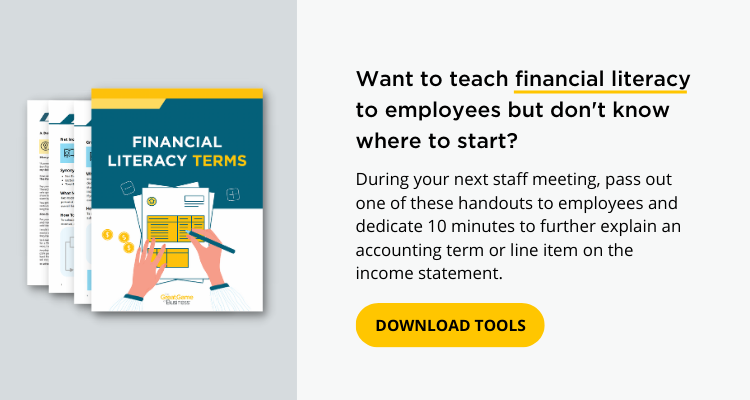 Most everyone, when asked what their most important asset is, will respond “our people”. If that is true, how much are we investing in our people to help them understand basic financial concepts? Training for employees in the area of financial literacy can be a challenging task. Here are some ideas that will help get the training started. The outcome will be better-engaged employees.
Most everyone, when asked what their most important asset is, will respond “our people”. If that is true, how much are we investing in our people to help them understand basic financial concepts? Training for employees in the area of financial literacy can be a challenging task. Here are some ideas that will help get the training started. The outcome will be better-engaged employees.
-
Use your regular meeting format.
During your regular huddles or staff meetings, inject some small training topics on a recurring basis to get the attendees familiar with the terminology and the idea of learning new things.
-
Make it challenging and fun.
A friend of mine used to say “If you’re not having fun, you’re done.” Well, that is a little dramatic but the principle is sound, if you want training to happen and not feel like everyone is back in school, interject some fun competitions, team challenges, and MiniGames, etc. If the games and challenges are carefully crafted, the employees will learn in spite of themselves and have fun while doing it.
-
Look for Team/Group leaders.
One person can’t train everyone without help unless that is their only job. Who has the time and resources for that? Use small group discussions and small team events to allow mentoring from the natural leaders you have in your organization. These natural leaders can take direction and run with it so that the training can happen on a more personal level than having everyone sit in a lecture hall for hours.

-
Keep things interesting.
Even though a game or contest works really well, keep the training fresh by introducing new methods or concepts. You can always come back to a particular game several months later because this type of training is ongoing. Just when you think you have everyone up to speed, new people get hired on and others take different positions so the level of knowledge is always changing. Make a long-range plan that can carry you from year to year to ensure continuity and sustainability of the training.
Many of us say that we are open-book management companies, but we don’t always connect with a key part of the purpose of open-book management: the desire to have a more engaged workforce. A certain amount of association will occur by routine repetition of financial numbers on a regular basis but to obtain a comprehensive understanding of business finances through financial literacy, a more targeted approach is required. Interactive meetings with targeted training objectives where employees are encouraged to participate on a consistent basis will turn the tide and lead to a workforce that truly will be more engaged and make better decisions.
.png)











.png)

